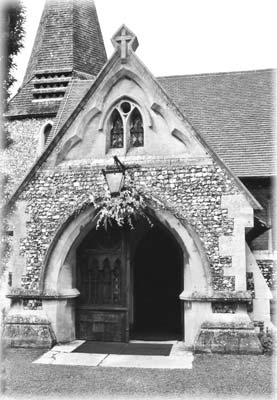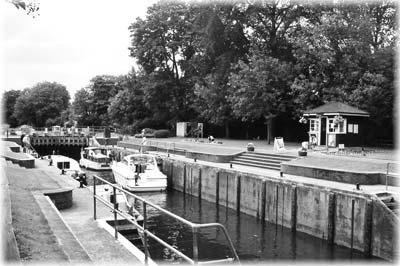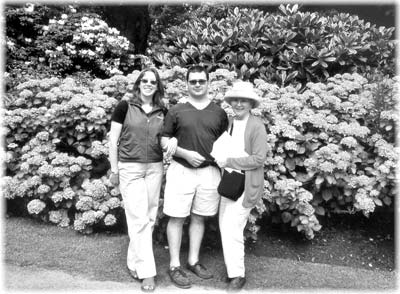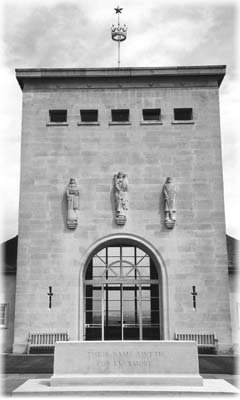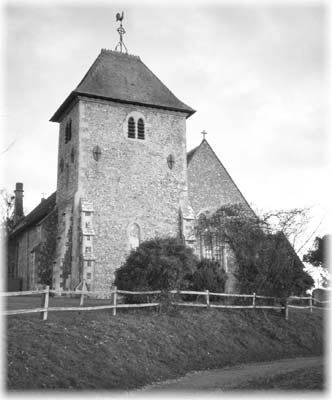Windsor — Beyond the castle
by Marisue Pickering, Orono, ME
As our well-used guidebook to Britain states, “Berkshire has one major tourist attraction: Windsor and its famous castle.” Although my husband and I agree with our travel guide about the premier status of this magnificent castle overlooking the Thames, we delight in discovering minor attractions of the area.
We have enjoyed the byways of Windsor and greater Berkshire in the months of January, March, June, July and November. Our first visit was in 2002 and this, our sixth, was in March 2005. The primary reason for our trips is to visit our son and his family who live in Windsor’s neighboring town of Slough.
We prefer not to drive in the U.K., so our family takes us on excursions by car; other times, we go off on our own, walking or using public transportation or a taxi.
What follows are a few of our favorite parts of Windsor and Berkshire. Windsor is a busy town, interestingly full of great British traditions and visitors from all over the world. Relatively unknown to American travelers, however, are the quieter parts of Windsor and Berkshire.
Church of St. Andrew
The Royal Windsor Information Center at 24 High Street is a gold mine. An early find of ours was a brochure entitled “Thames Walks around Windsor.” From this we learned about the Church of St. Andrew, located in the Clewer section of Windsor and billed as the town’s oldest building.
Following the brochure’s Walk No. 4 on a July Saturday, we entered the courtyard just as a wedding party was leaving. Trying to remain unnoticed behind an immense yew tree, we waited until the church appeared empty before approaching it. To our surprise, a churchwarden came out and kindly offered to show us inside.
The small dark stone church has numerous items of ecclesiastical, historic and aesthetic interest. And it is old — according to our brochure, the current structure was begun in 1125.
The brochure also indicates that when William the Conqueror arrived in Windsor after his 1066 victory, people were already worshiping on this Clewer site half a mile upstream from the cliffs that ultimately would house his castle. The history of the original (probably wooden) building is unclear; nevertheless, the church contains a Saxon font that predates William’s arrival in Windsor.
The churchyard appeared overgrown to us, and then we understood why — it is part of the Living Churchyard Project, a conservation movement dedicated to offering sanctuary within a natural habitat to endangered plant and bird species. Part of St. Andrew’s churchyard is devoted to wildflowers that are becoming scarce in the area. Thousands of churches throughout Britain are part of this project.
From the castle, the round-trip walk is about three miles.
Romney Lock
A Windsor walk we have enjoyed in more than one season is one along the path beside the Thames, heading downriver to the Romney Lock. Although not a numbered walk in our brochure, it is identified on the brochure’s map and is about two miles round trip from the castle. Part of the walk is through “urban” Windsor, part within sight of the Thames and part beside the Romney boatyard. The walk is almost as interesting as the destination.
Summertime, in particular, sees a large number of boats going up and down the Thames, but at any time of the year they have to be raised and lowered by locks, of which there are 45 on the 180-mile river. The Romney Lock, dating from the 1790s, is the closest one to Windsor and provides an easy opportunity to learn how locks function.
We also find that spending time watching the boats in the lock slowly rise and fall is an almost mesmerizing endeavor and a nice counterpoint to Windsor’s crowds. And it’s fun to chat with and wave to the people on the boats. A bonus is the lovely landscaping along the lock’s banks.
Savill Garden
Each visit to Windsor has included at least half a day in the 35-acre, woodland-style Savill Garden, located 4½ miles from the castle. Part of Windsor Great Park, Savill Garden is owned by the Crown Estate and is open to the public (around £5 per person).
During our March ’05 visit, we enjoyed fields of dwarf daffodils, camellias and crocuses (two months before we would see them in Maine) in the Temperate House. Winter vegetation is lush with yew, holly, mahonia and rhododendron; summer shows off roses and hydrangeas in profusion. And we frequently come across a pheasant or two wandering the paths.
On visits to Savill, we include a meal in the cafeteria-style restaurant overlooking the gardens. Because we are vegetarians, we appreciate that the restaurant always has at least one vegetarian option.
The gift shop, where I like to pick up items made from English lavender and English rose for friends, is also worth a visit.
We usually take a cab from Windsor to Savill Garden, keeping a business card from the taxi company and phoning when we are ready to leave the garden. The fee is about £10 ($17) one way.
We have never encountered more than a few people in the garden itself, although we do visit on weekdays, not on a weekend. This is a quiet, peaceful place and true to the promotional literature that calls it a “garden for all seasons.”
It is open every day except Dec. 25 and 26; hours vary with the season.
Commonwealth Air Forces Memorial
A highlight of our latest trip was a return to the Commonwealth Air Forces Memorial located on Cooper’s Hill in Englefield Green, a village about four miles downriver from Windsor.
We went there by car with our family. The memorial overlooks the Thames and historic Runnymede, where tradition indicates the Magna Carta was signed in 1215.
The memorial identifies and honors WWII men and women from all over the then British Empire who have no known graves. The more than 20,000 individuals commemorated were lost in forays originating in the U.K. and Western Europe.
Also honored are “freedom fighters,” those people who left countries overrun by the Axis powers to come to Britain to fly with the RAF — and who died with their RAF comrades.
In some ways, the Commonwealth Air Forces Memorial reminds me of the Vietnam Memorial in Washington, D.C., in that people leave photographs, letters, poems and flowers near the names of loved ones. Part of the impact of this memorial comes in realizing that the people who are being personally remembered have been deceased for 60-plus years.
The memorial is open every day except Christmas and New Year’s Day, but the hours vary with the season. There is no charge, and we have seen very few people there when we went.
The village of Aldworth
Our English daughter-in-law has a book describing out-of-the way places in Berkshire, and during our November ’03 trip she planned a day that included a visit to St. Mary the Virgin, a parish church in the Berkshire village of Aldworth (population fewer than 300). This small church, dating back to the early 1200s, contains nine 14th-century stone effigies representing five generations of the de la Beche family, who settled in the area probably in the early 13th century.
At around seven feet tall, the stone effigies either are larger-than-life figures or represent true giants. Whichever it is, they are known as the “Aldworth giants.”
Lying in impressive splendor throughout the church, they dominate the interior. Their presence, with their stone medieval garments and weaponry, is a moving reminder of the individual people who make up English history.
The churchyard has its own attraction in a yew tree estimated to be at least 1,000 years old and perhaps the oldest in the country. The tree is thought to be the inspiration for Tennyson’s line about an old yew in his poem “In Memoriam.” Tennyson’s wife was from this area of England, and members of her family are buried in the church.
Our visit was on a cold winter day as the sun was setting, and we encountered no one else as we wandered through the church and churchyard — facts that added to the ambiance of the site.
As we drove toward the church, we passed a farm with signage identifying it as belonging to de la Beche. It is hard for me, as an American with immigrant roots, to imagine what it means to belong to a family who has lived in an area for approximately 800 years.
Aldworth’s location in the western part of Berkshire is in beautiful countryside of rolling terrain with pastoral scenes of sheep and cattle, open fields and large vistas. We took the B4009 to Aldworth; the church is located slightly off this road.
Near the church is the Four Points Pub, where we had a very good ploughman’s lunch and were served by a helpful young waiter who explained the featured dessert, Maltesers Melt: ice cream with crushed Maltesers candy (small chocolate balls with crisp, light, honeycombed centers) covered by melted chocolate. He was surprised I had not heard of Maltesers and even more surprised when I turned down the dessert, but I was too full.
Trip details
Because our son’s flat is very small, we do not stay there. On early trips we stayed at various B&Bs in Windsor, but for the last three visits we have stayed at Travelodge Slough (phone 0870 191 1754; www.travelodge.co.uk). Not only is this hotel within a block of our family, it is close to the major shopping center in downtown Slough, so we can buy breakfast to take back to our room. It is a 30- to 40-minute walk to the castle in Windsor.
Located on Herschel Street, the hotel is basic and has some confusing protocols. For example, each time we have stayed there the maids have taken away two sets of towels each day and returned one set, so every day we need to ask for more. The rooms have no telephones; the guest is expected to have a cell phone.
But the advantages of the hotel, for us, are twofold: location and cost. In March ’05 we paid £42.50 ($74) per night, which is considerably less than the price at most Windsor-area hotels.
Because of the variations in weather in every season in this part of England, we take water-resistant walking shoes, clothes we can layer and umbrellas.
We strongly recommend going to the Royal Windsor Information Center mentioned earlier. The staff is helpful and can point the visitor to Windsor’s many off-the-beaten-track attractions — once the castle has been toured!


